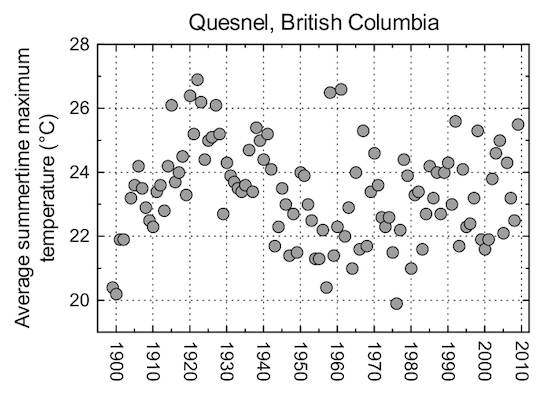By Sierra Rayne ——Bio and Archives--February 4, 2015
Global Warming-Energy-Environment | CFP Comments | Reader Friendly | Subscribe | Email Us
"From around 1900 to 2010, the temperatures measured over a year increased by about 0.22 degrees a decade. But over the next three decades, projections show it go up by nearly five times that. Fort St. John and area is expected to shift by a few degrees. The temperature weather over the winter is projected to raise by four degrees Celsius."The rate of temperature increase for the region over the next 30 years is supposed to be five times the rate observed from 1900 to 2010, even though the last 30 years have seen no warming whatsoever (and even evidence of cooling trends)? The prediction that winter temperatures in the Fort St. John region are "projected to raise by four degrees Celsius" over the next three decades is rather odd given that this region has experienced a negative correlation towards cooling winter temperatures over the last three decades. Then there are worries about rising summertime temperatures:
"The number of days where it is extremely hot are also expected to increase. 'Hotter extreme summer temperatures can affect worker health and safety, increase forest fire risk, and lead to warmer water temperatures and lower water levels (that affect fish, agriculture, and hydroelectric activities),' information presented by [Ian] Picketts [a physical sciences tutor with Quest University] noted."There has been no significant trend in average summertime maximum temperatures for Fort St. John since records began in 1939. Actually, the correlation since 1939 is towards cooler summer maximum temperatures, not warmer. No significant increase over the last three decades, either. Same story at Fort Nelson, Prince George, and Quesnel. Not even a remote hint of a significant trend in summer maximum temperatures since records began, or over the last three decades. Quesnel has the longest climate record, dating back to 1899. Here are the summertime average maximum temperatures since records began for this area.
 There is an overall negative correlation towards cooler summer maximum temperatures in this region since 1899, and during the last three decades there is a perfect non-correlation. Climate crisis? No chance.
There is an overall negative correlation towards cooler summer maximum temperatures in this region since 1899, and during the last three decades there is a perfect non-correlation. Climate crisis? No chance.
View Comments
Sierra Rayne holds a Ph.D. in Chemistry and writes regularly on environment, energy, and national security topics. He can be found on Twitter at @srayne_ca